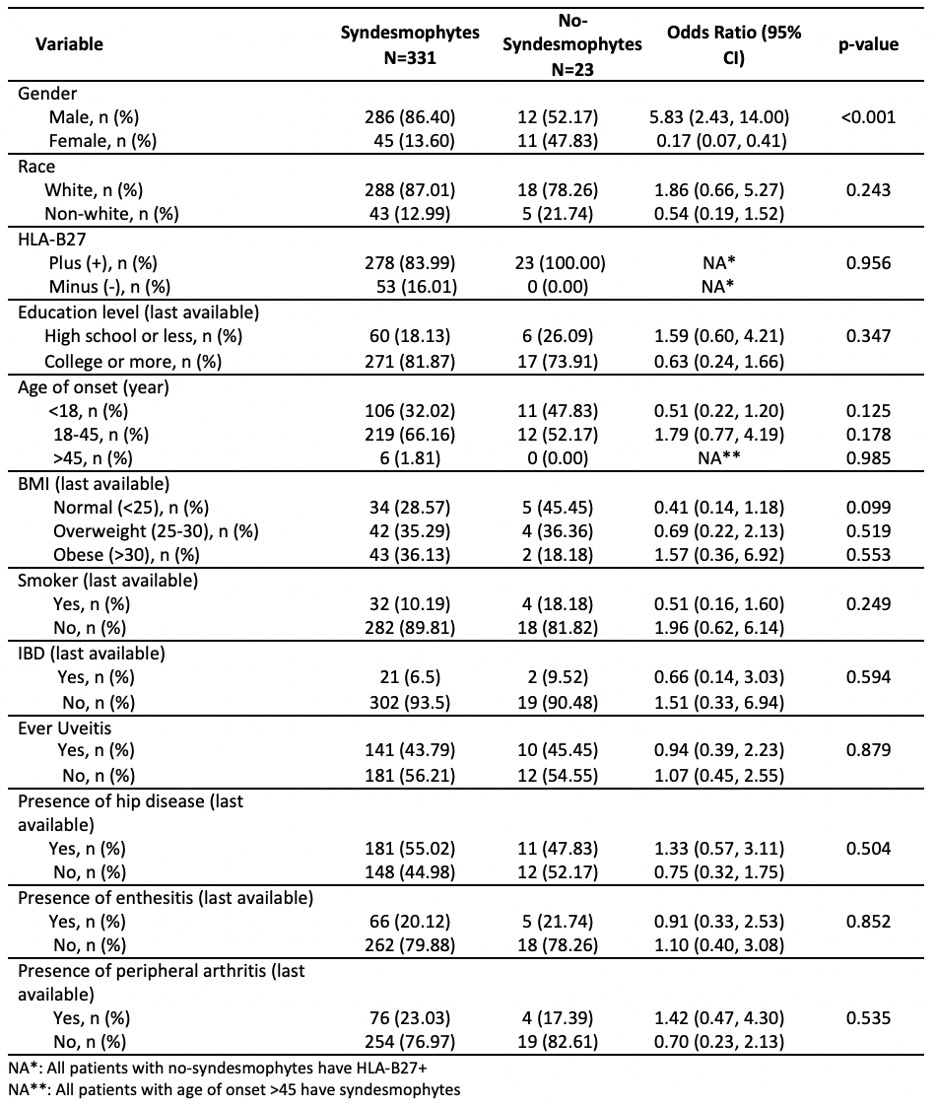Session Information
Date: Sunday, November 7, 2021
Session Type: Poster Session B
Session Time: 8:30AM-10:30AM
Background/Purpose: Ankylosing Spondylitis describes disorders of inflammation and damage to the spine and sacroiliac (SI) joints. Clinicians have observed, on occasion, AS subjects with fused SI joints but little or no spinal involvement; is there truly a subgroup with fused SI joints and long-standing disease but absent radiographically demonstrated spinal syndesmophytes? No study has assessed the subset with long standing disease with fused SI joints but no radiographic spinal disease. Using a large multi-center cohort, the purpose of this study was to identify factors associated with discordant SI joint and spinal radiographic severity in AS patients.
Methods: Patients met the modified New York criteria for AS. Study visits every 4-6 months included CRP levels, demographic and social information. Radiographs of the pelvis and lateral spine were performed every 2 years. We included 354 patients with fused SI joints and disease duration of at least 20 years. We employed classification and regression trees (CART) analysis to examine the subset of patients with fused SI joints but no syndesmophytes. We defined no-syndesmophytes as mSASSS< 2 at all cervical- and lumbar-spine levels, and the presence of syndesmophytes as mSASSS≥ 2. We also conducted logistic regression models.
Results: Of the 354 patients with long standing disease and fused SI joints, 6.5% did not have syndesmophytes. Gender was the strongest factor associated with lack of syndesmophytes on CART analysis. Females accounted for 16% of the subgroup, and of these, 20% did not have syndesmophytes. Males were 84% of the subgroup and 4% did not have syndesmophytes (Figure 1). Univariable logistic regression modeling corroborated this finding with OR 5.83 (95% CI 2.43, 14.00), p-value was < 0.001 with females more likely to not have syndesmophytes (Table 1).
In men, age of onset was the next important predictor. 26% of males had age of symptom onset less than 18 years, and 8.6% of these did not have syndesmophytes (Figure 1). Investigating interactions between male gender and age of symptom onset, on multivariable analysis the p-value was 0.006 with OR 35.65 (95% CI 2.81, 451.60) (Table 2) with men who had age of symptom onset < 18 years being less likely to have syndesmophytes.
All 23 patients who did not have syndesmophytes were HLA-B27 positive.
Conclusion: Of our subgroup, 6.5% of patients lacked syndesmophytes. Gender was the most important variable, with women being more likely to lack syndesmophytes despite having complete SI fusion with long disease duration. Age of symptom onset may also be an important variable in male gender subjects. All of the non-syndesmophyte group were HLA-B27 positive raising the possibility that HLA-B27 positivity may be more associated with sacroiliitis than proliferative spinal bone disease. Our study is distinct in assessing this subpopulation of fused SI joints with long disease duration but no spinal disease. Further studies are needed to elucidate why AS disease behaves differently in this and other subgroups.
To cite this abstract in AMA style:
Ridley L, Hwang M, Reveille J, Gensler L, Ishimori M, Brown M, Rahbar M, Tahanan A, Ward M, Weisman M, Learch T. The Phenomenon of Fused Sacroiliac Joints but Absent Syndesmophytes in Long Standing Ankylosing Spondylitis Patients: Data from a Prospectively Followed Cohort [abstract]. Arthritis Rheumatol. 2021; 73 (suppl 9). https://acrabstracts.org/abstract/the-phenomenon-of-fused-sacroiliac-joints-but-absent-syndesmophytes-in-long-standing-ankylosing-spondylitis-patients-data-from-a-prospectively-followed-cohort/. Accessed .« Back to ACR Convergence 2021
ACR Meeting Abstracts - https://acrabstracts.org/abstract/the-phenomenon-of-fused-sacroiliac-joints-but-absent-syndesmophytes-in-long-standing-ankylosing-spondylitis-patients-data-from-a-prospectively-followed-cohort/



